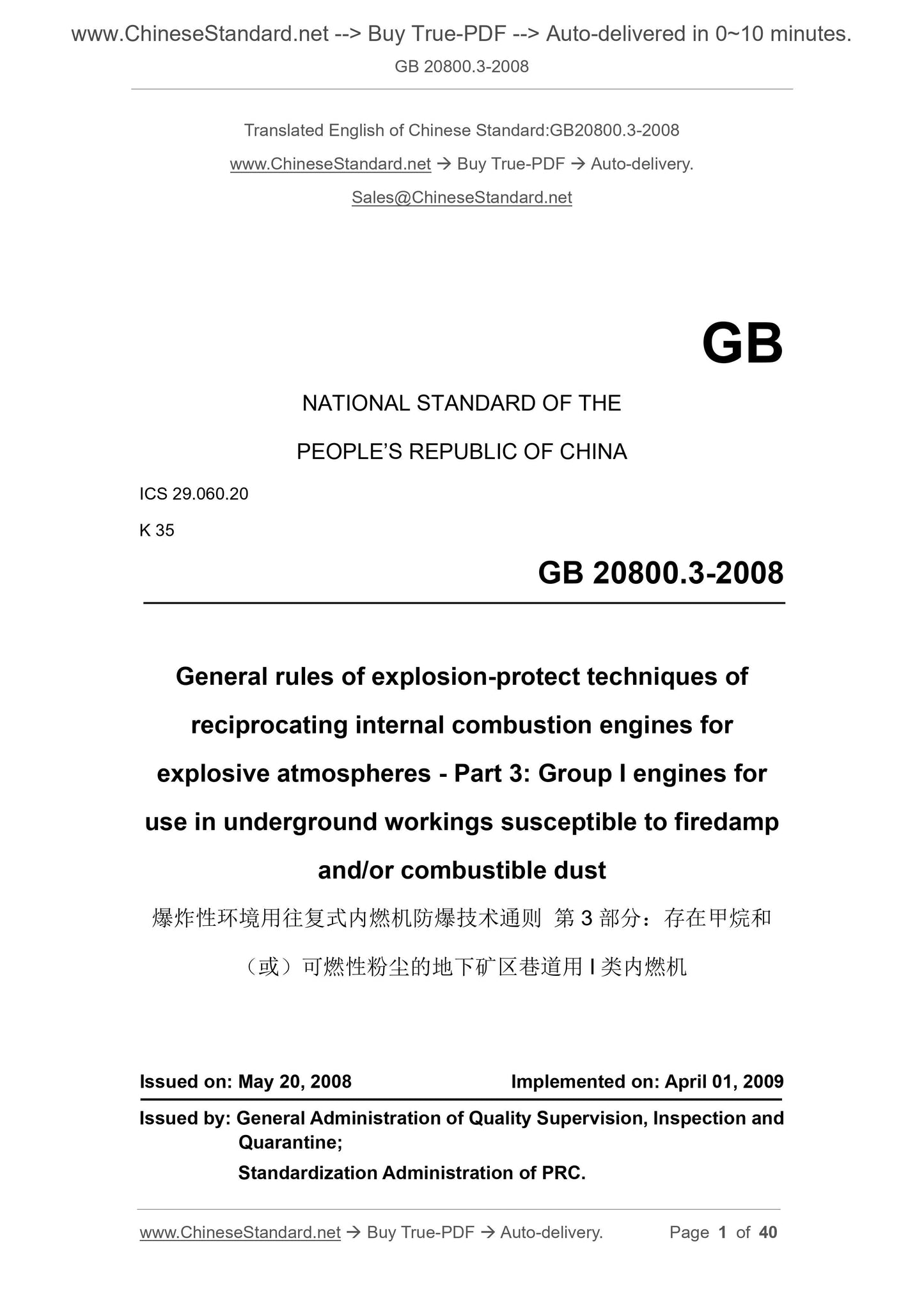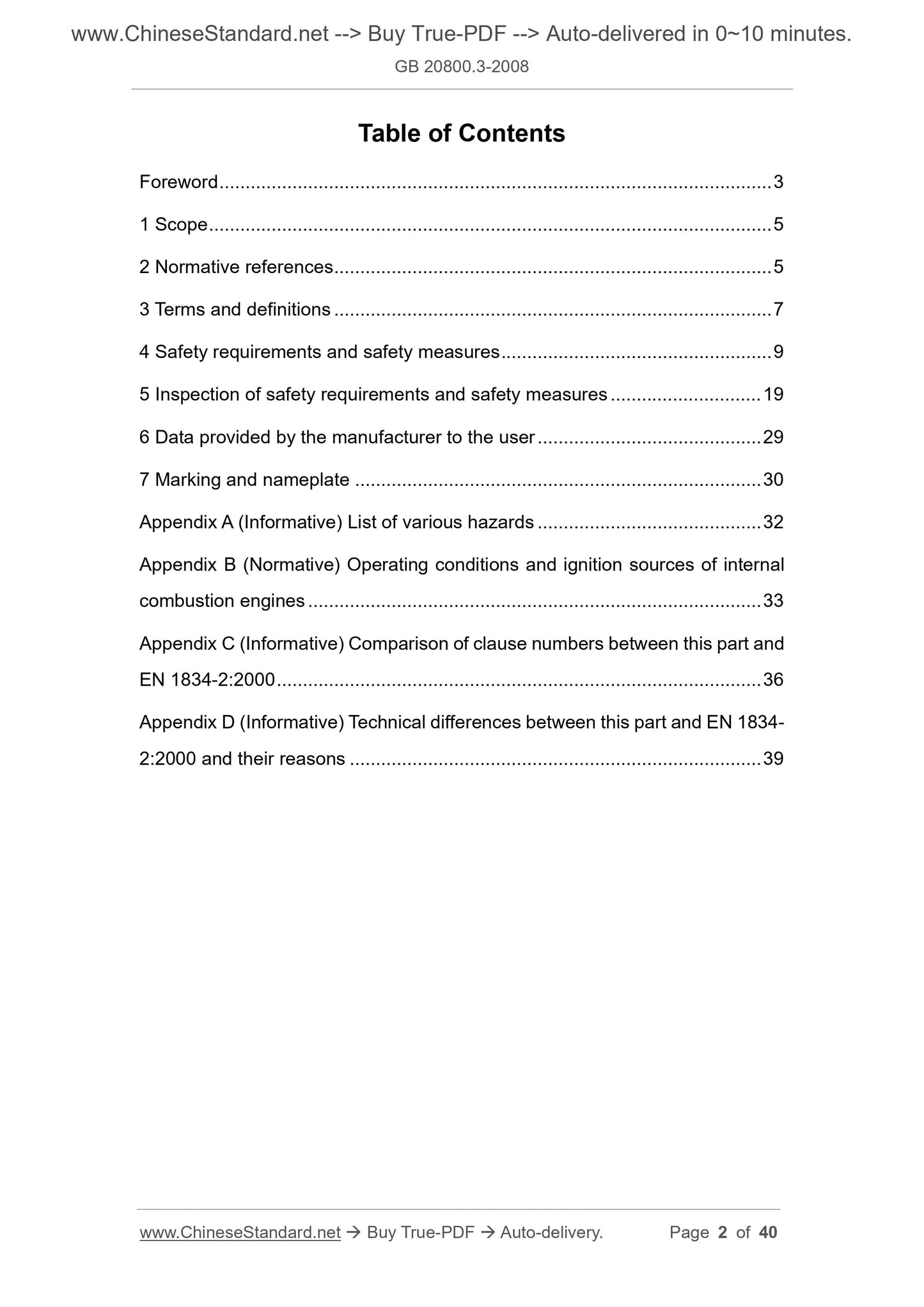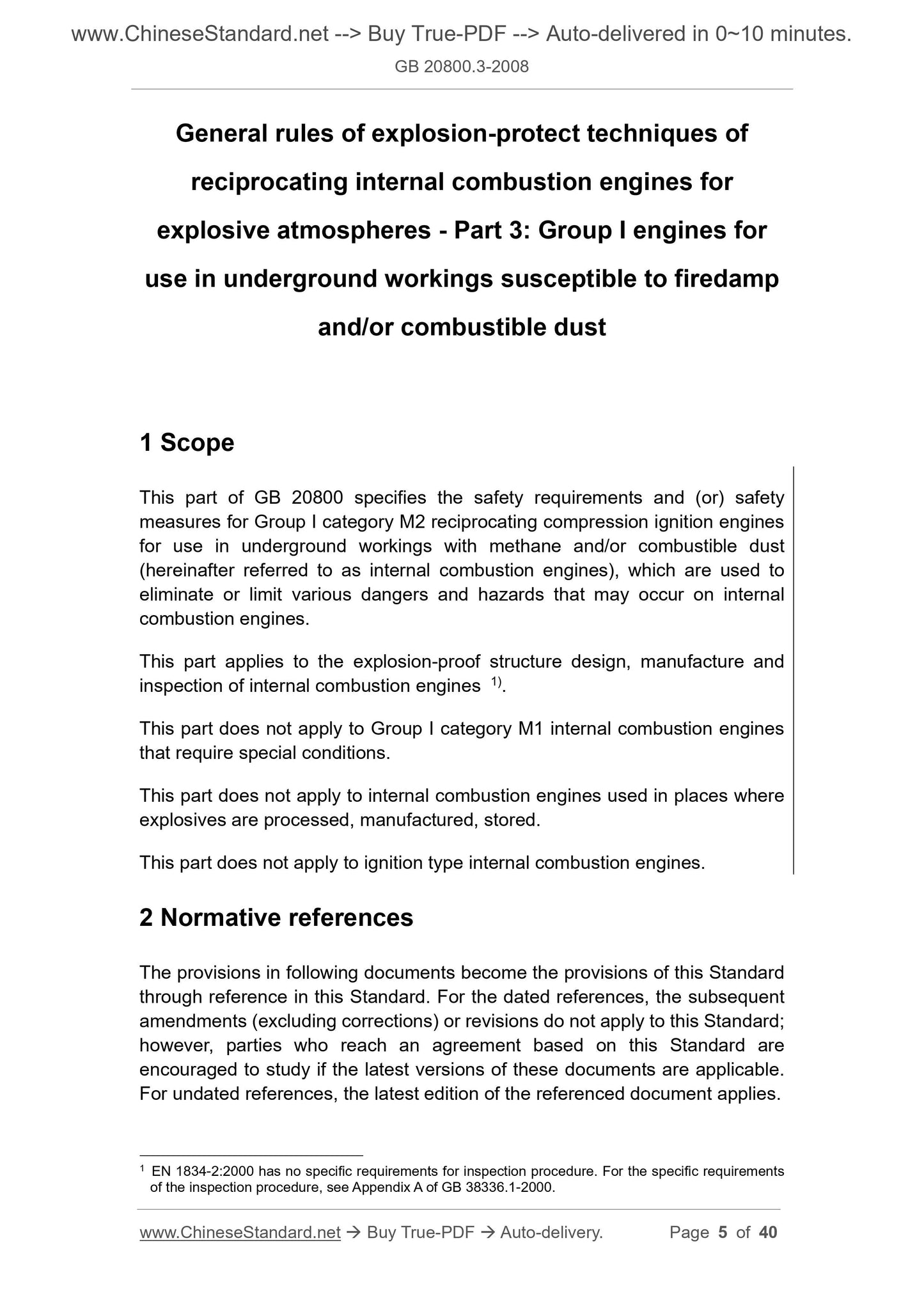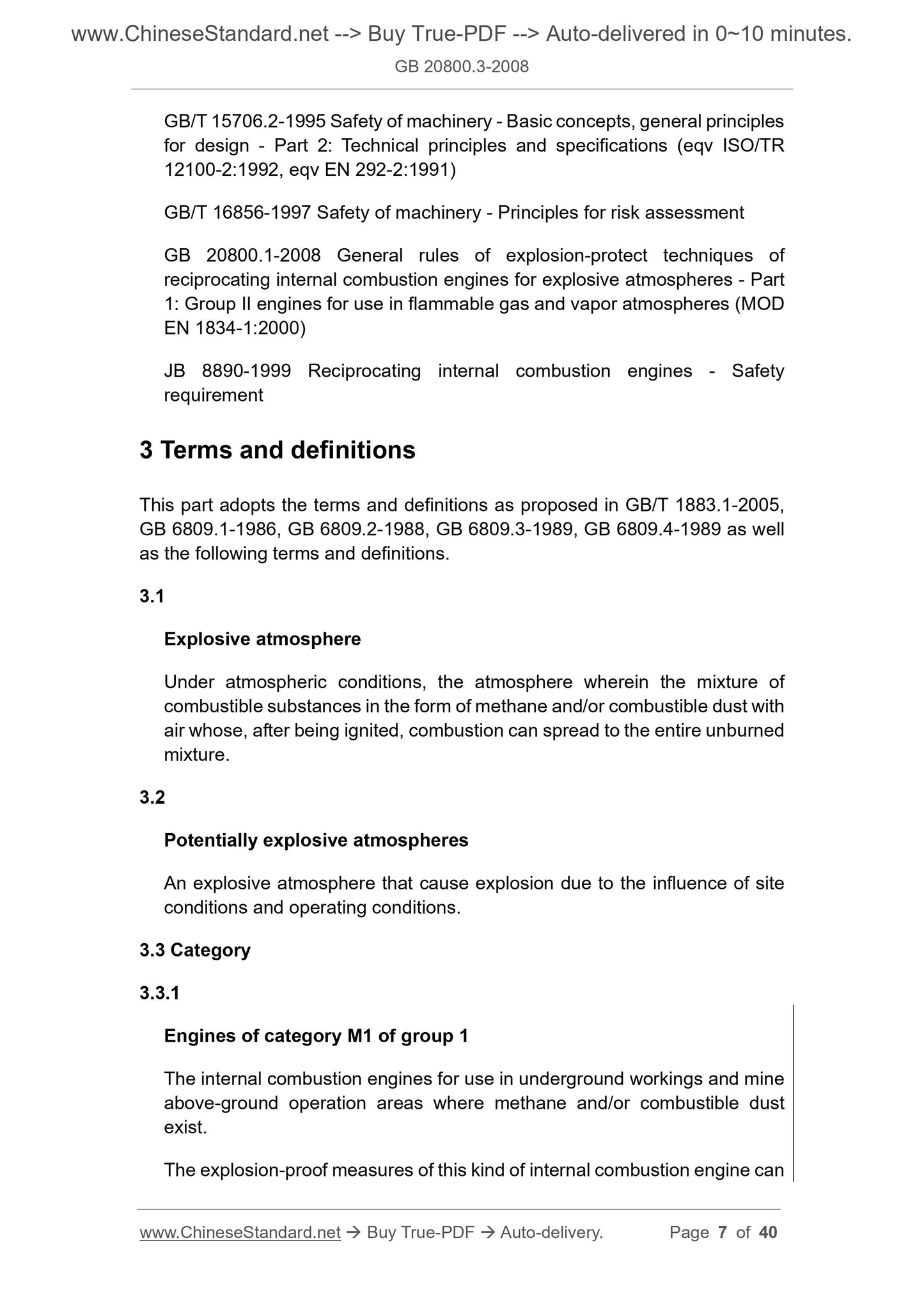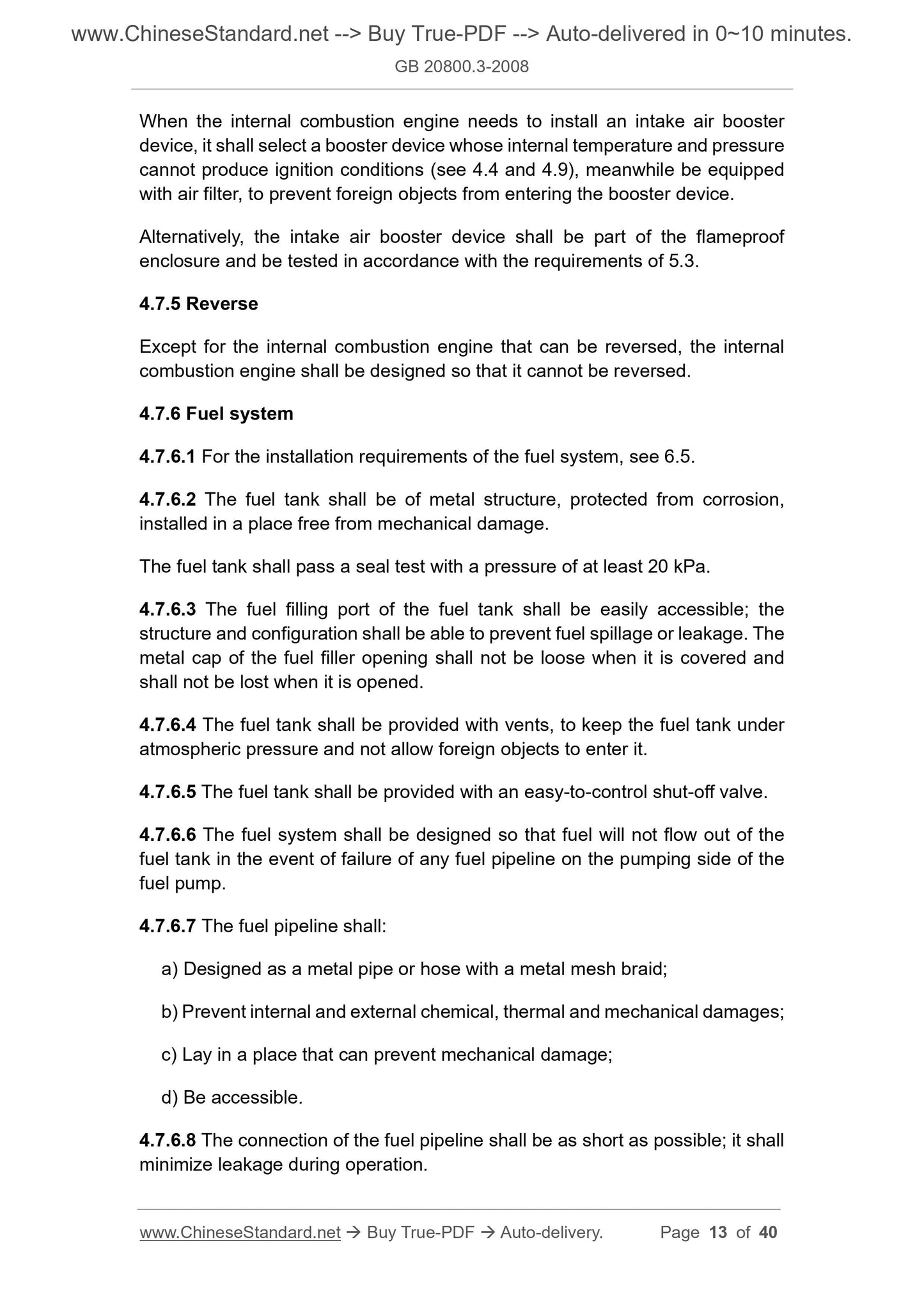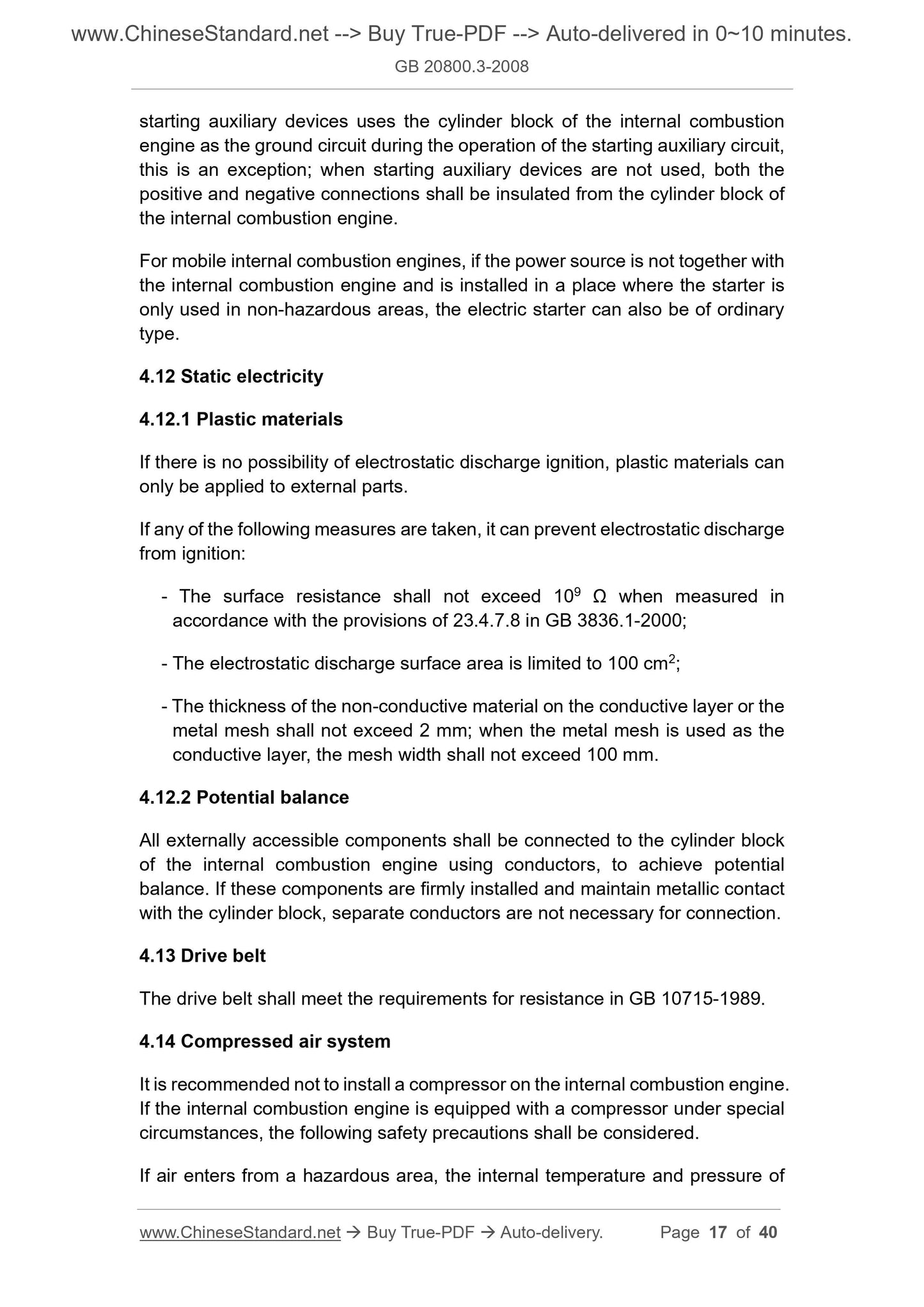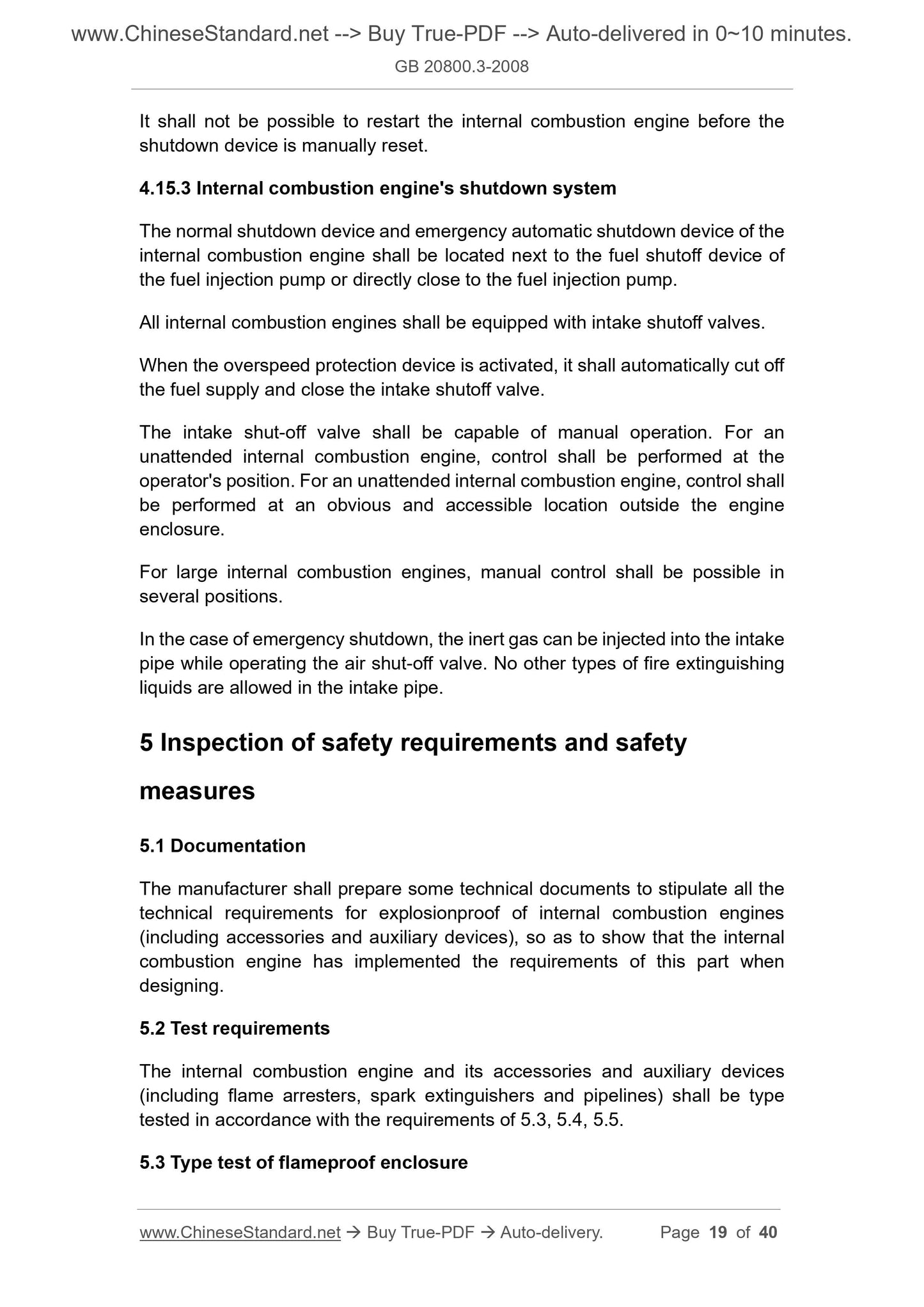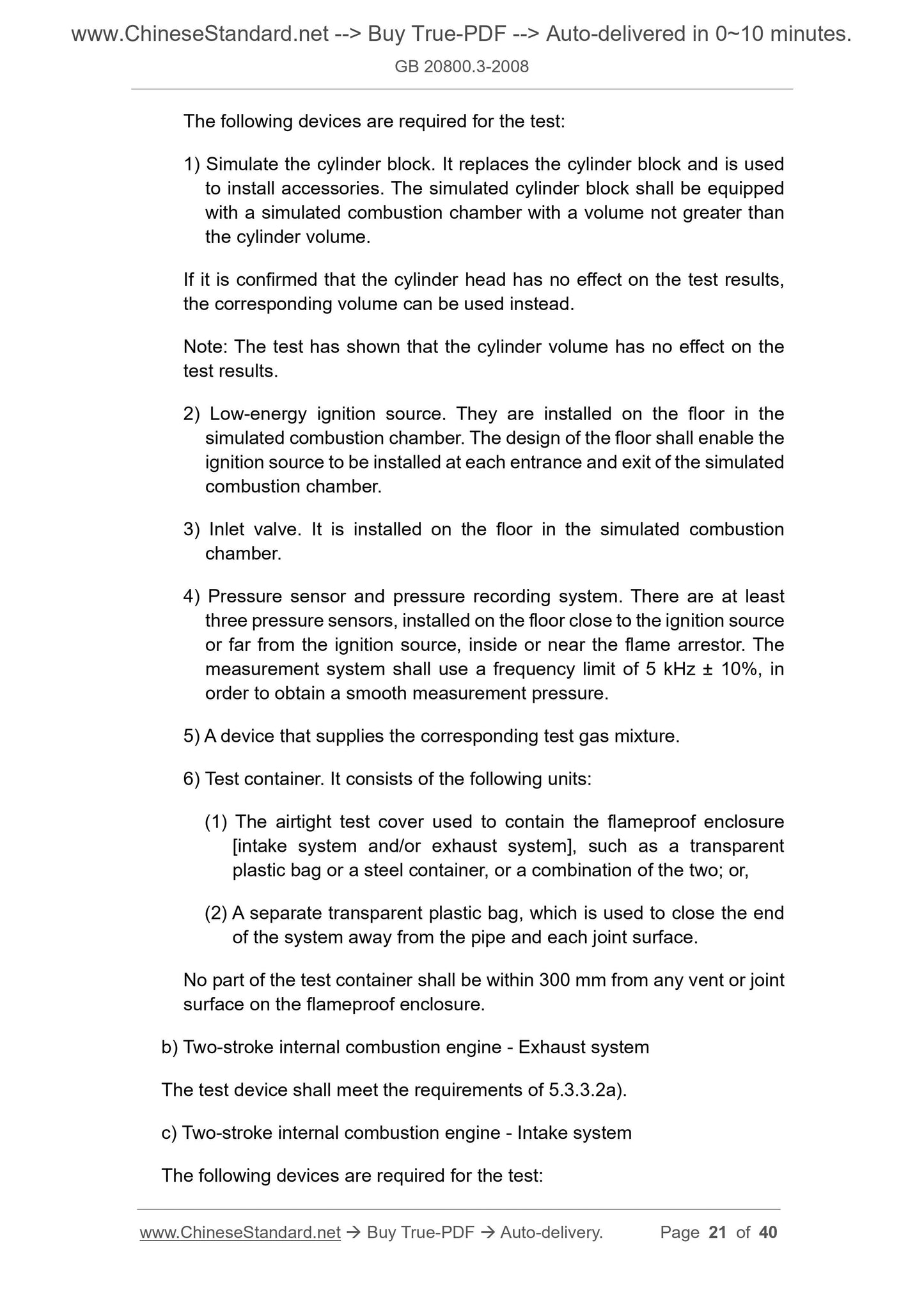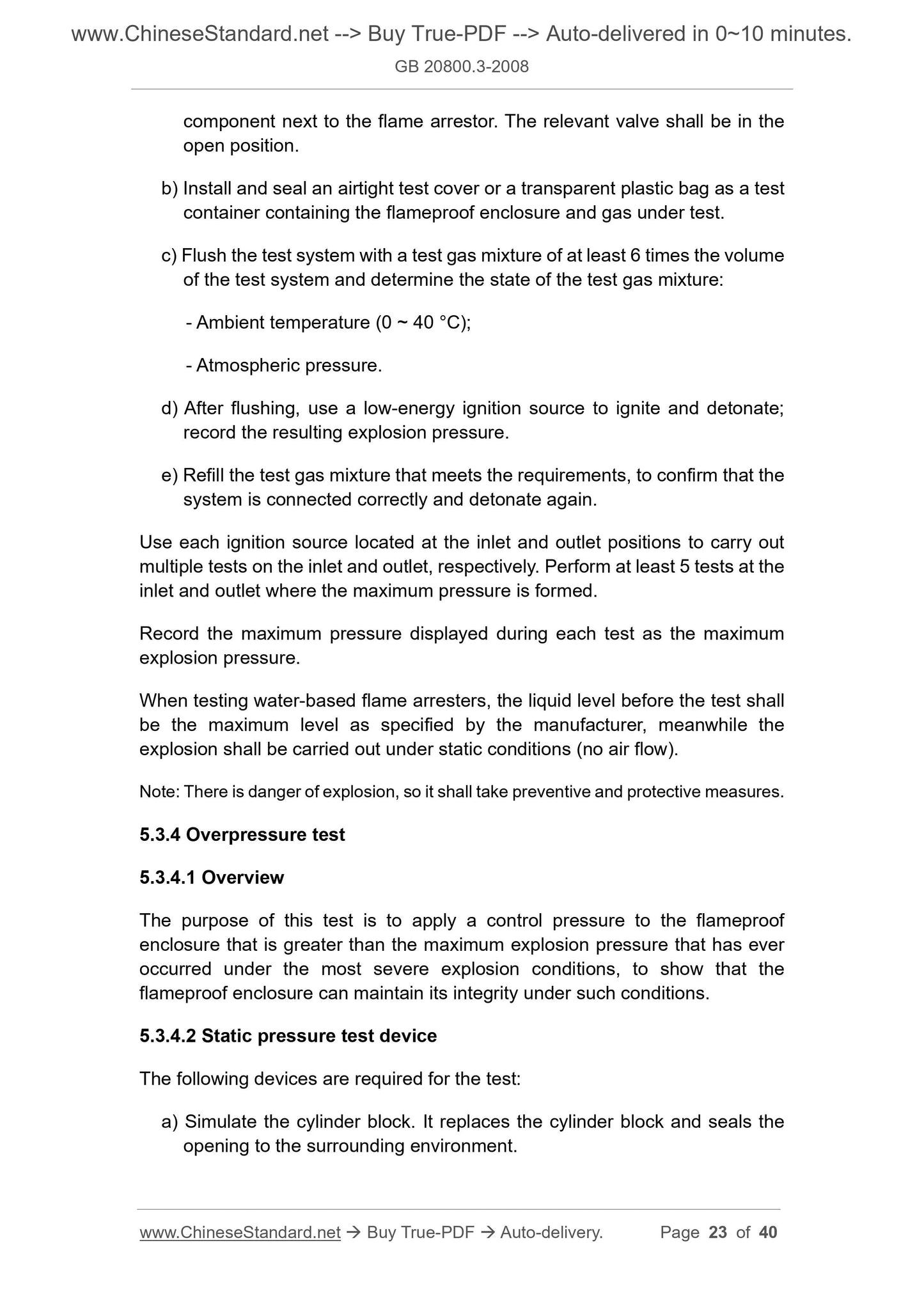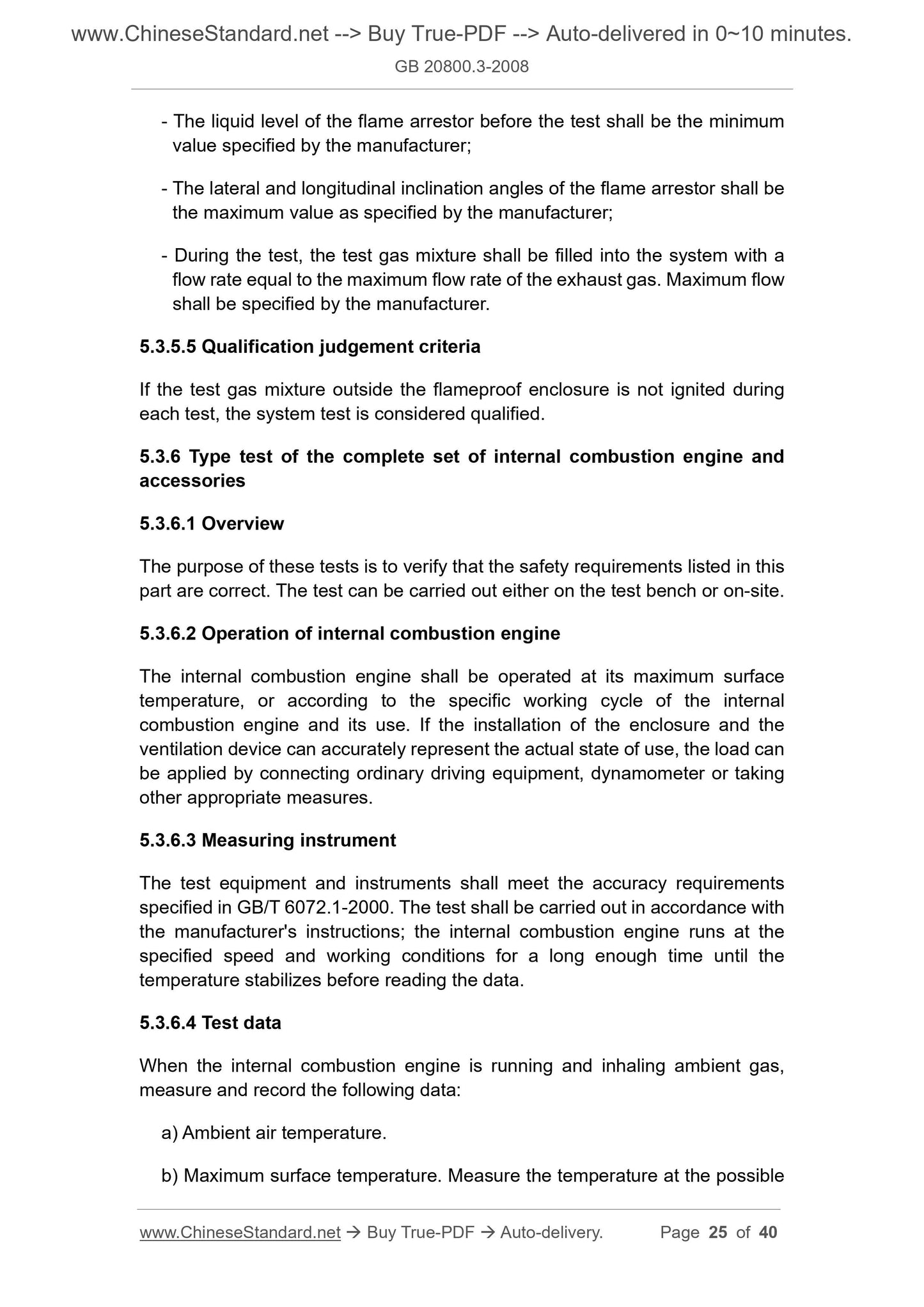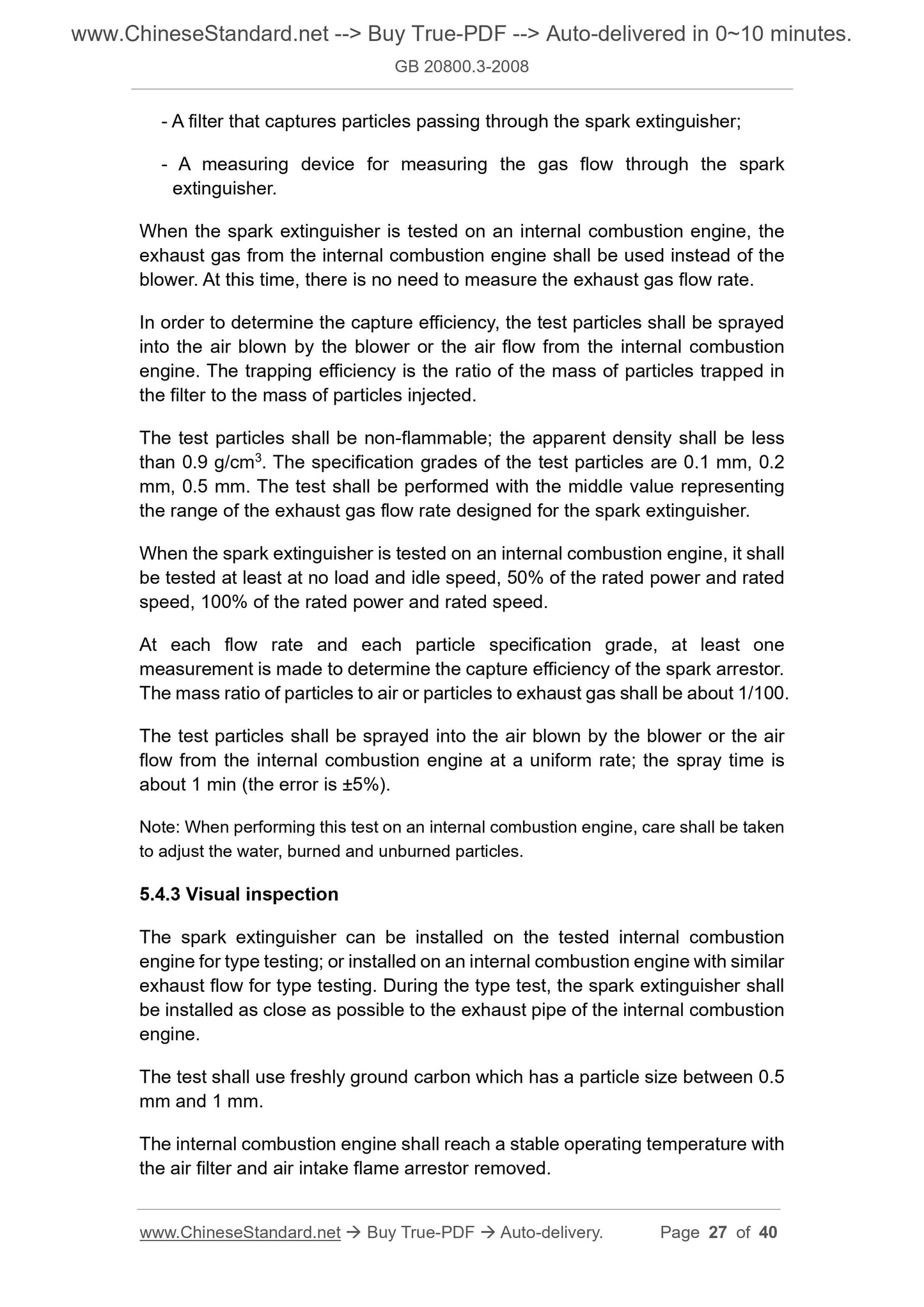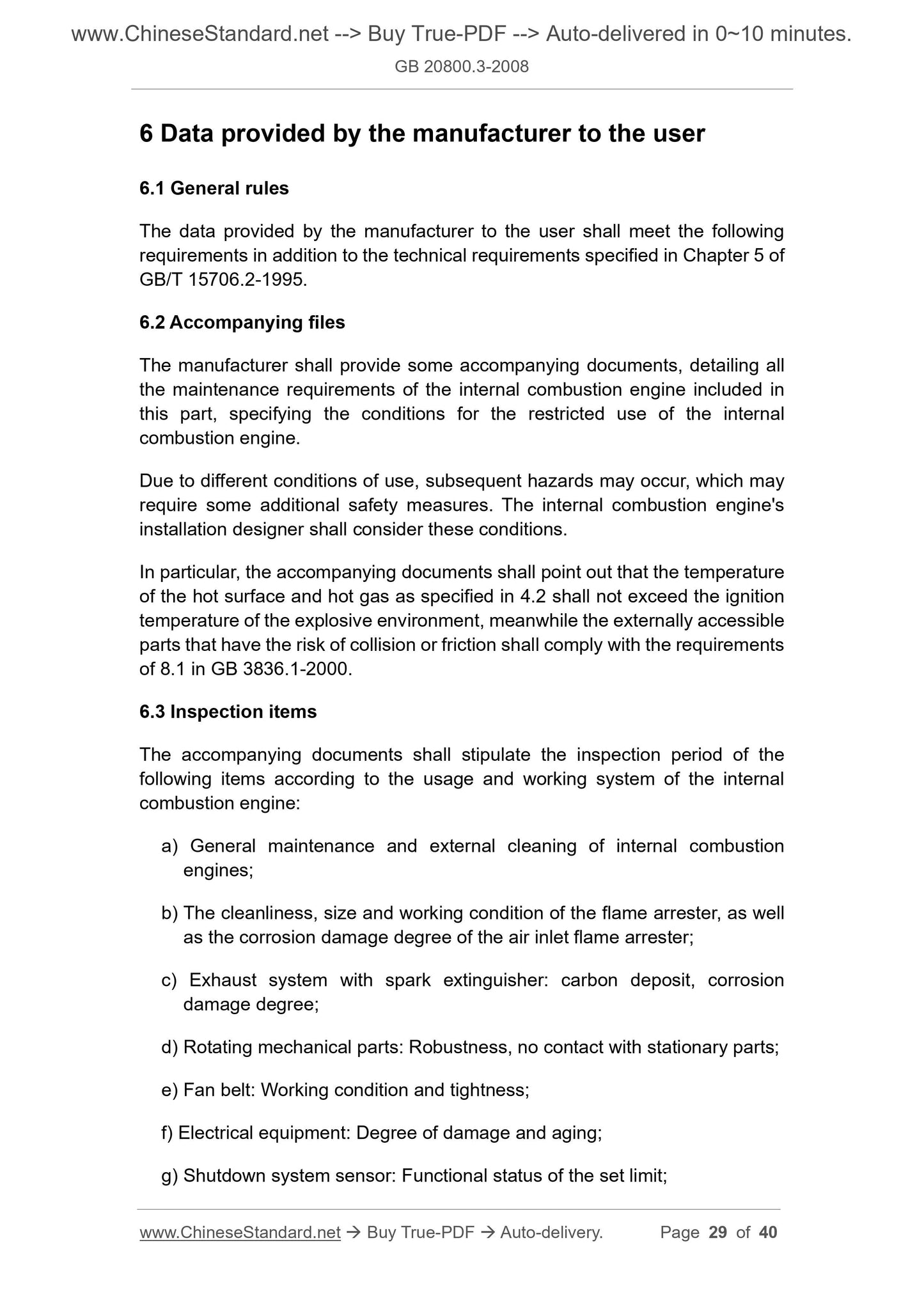1
/
of
12
PayPal, credit cards. Download editable-PDF & invoice In 1 second!
GB 20800.3-2008 English PDF (GB20800.3-2008)
GB 20800.3-2008 English PDF (GB20800.3-2008)
Regular price
$205.00 USD
Regular price
Sale price
$205.00 USD
Unit price
/
per
Shipping calculated at checkout.
Couldn't load pickup availability
Delivery: 3 seconds. Download true-PDF + Invoice.
Get QUOTATION in 1-minute: Click GB 20800.3-2008
Historical versions: GB 20800.3-2008
Preview True-PDF (Reload/Scroll if blank)
GB 20800.3-2008: General rules of explosion-protect techniques of reciprocating internal combustion engines for explosive atmospheres -- Part 3: Group I engines for use in underground workings susceptible to firedamp and/or combustible dust
GB 20800.3-2008
GB
NATIONAL STANDARD OF THE
PEOPLE’S REPUBLIC OF CHINA
ICS 29.060.20
K 35
General rules of explosion-protect techniques of
reciprocating internal combustion engines for
explosive atmospheres - Part 3: Group I engines for
use in underground workings susceptible to firedamp
and/or combustible dust
ISSUED ON: MAY 20, 2008
IMPLEMENTED ON: APRIL 01, 2009
Issued by: General Administration of Quality Supervision, Inspection and
Quarantine;
Standardization Administration of PRC.
Table of Contents
Foreword ... 3
1 Scope ... 5
2 Normative references ... 5
3 Terms and definitions ... 7
4 Safety requirements and safety measures ... 9
5 Inspection of safety requirements and safety measures ... 19
6 Data provided by the manufacturer to the user ... 29
7 Marking and nameplate ... 30
Appendix A (Informative) List of various hazards ... 32
Appendix B (Normative) Operating conditions and ignition sources of internal
combustion engines ... 33
Appendix C (Informative) Comparison of clause numbers between this part and
EN 1834-2:2000 ... 36
Appendix D (Informative) Technical differences between this part and EN 1834-
2:2000 and their reasons ... 39
General rules of explosion-protect techniques of
reciprocating internal combustion engines for
explosive atmospheres - Part 3: Group I engines for
use in underground workings susceptible to firedamp
and/or combustible dust
1 Scope
This part of GB 20800 specifies the safety requirements and (or) safety
measures for Group I category M2 reciprocating compression ignition engines
for use in underground workings with methane and/or combustible dust
(hereinafter referred to as internal combustion engines), which are used to
eliminate or limit various dangers and hazards that may occur on internal
combustion engines.
This part applies to the explosion-proof structure design, manufacture and
inspection of internal combustion engines 1).
This part does not apply to Group I category M1 internal combustion engines
that require special conditions.
This part does not apply to internal combustion engines used in places where
explosives are processed, manufactured, stored.
This part does not apply to ignition type internal combustion engines.
2 Normative references
The provisions in following documents become the provisions of this Standard
through reference in this Standard. For the dated references, the subsequent
amendments (excluding corrections) or revisions do not apply to this Standard;
however, parties who reach an agreement based on this Standard are
encouraged to study if the latest versions of these documents are applicable.
For undated references, the latest edition of the referenced document applies.
1 EN 1834-2:2000 has no specific requirements for inspection procedure. For the specific requirements
of the inspection procedure, see Appendix A of GB 38336.1-2000.
GB/T 15706.2-1995 Safety of machinery - Basic concepts, general principles
for design - Part 2: Technical principles and specifications (eqv ISO/TR
12100-2:1992, eqv EN 292-2:1991)
GB/T 16856-1997 Safety of machinery - Principles for risk assessment
GB 20800.1-2008 General rules of explosion-protect techniques of
reciprocating internal combustion engines for explosive atmospheres - Part
1: Group II engines for use in flammable gas and vapor atmospheres (MOD
EN 1834-1:2000)
JB 8890-1999 Reciprocating internal combustion engines - Safety
requirement
3 Terms and definitions
This part adopts the terms and definitions as proposed in GB/T 1883.1-2005,
GB 6809.1-1986, GB 6809.2-1988, GB 6809.3-1989, GB 6809.4-1989 as well
as the following terms and definitions.
3.1
Explosive atmosphere
Under atmospheric conditions, the atmosphere wherein the mixture of
combustible substances in the form of methane and/or combustible dust with
air whose, after being ignited, combustion can spread to the entire unburned
mixture.
3.2
Potentially explosive atmospheres
An explosive atmosphere that cause explosion due to the influence of site
conditions and operating conditions.
3.3 Category
3.3.1
Engines of category M1 of group 1
The internal combustion engines for use in underground workings and mine
above-ground operation areas where methane and/or combustible dust
exist.
The explosion-proof measures of this kind of internal combustion engine can
When the internal combustion engine needs to install an intake air booster
device, it shall select a booster device whose internal temperature and pressure
cannot produce ignition conditions (see 4.4 and 4.9), meanwhile be equipped
with air filter, to prevent foreign objects from entering the booster device.
Alternatively, the intake air booster device shall be part of the flameproof
enclosure and be tested in accordance with the requirements of 5.3.
4.7.5 Reverse
Except for the internal combustion engine that can be reversed, the internal
combustion engine shall be designed so that it cannot be reversed.
4.7.6 Fuel system
4.7.6.1 For the installation requirements of the fuel system, see 6.5.
4.7.6.2 The fuel tank shall be of metal structure, protected from corrosion,
installed in a place free from mechanical damage.
The fuel tank shall pass a seal test with a pressure of at least 20 kPa.
4.7.6.3 The fuel filling port of the fuel tank shall be easily accessible; the
structure and configuration shall be able to prevent fuel spillage or leakage. The
metal cap of the fuel filler opening shall not be loose when it is covered and
shall not be lost when it is opened.
4.7.6.4 The fuel tank shall be provided with vents, to keep the fuel tank under
atmospheric pressure and not allow foreign objects to enter it.
4.7.6.5 The fuel tank shall be provided with an easy-to-control shut-off valve.
4.7.6.6 The fuel system shall be designed so that fuel will not flow out of the
fuel tank in the event of failure of any fuel pipeline on the pumping side of the
fuel pump.
4.7.6.7 The fuel pipeline shall:
a) Designed as a metal pipe or hose with a metal mesh braid;
b) Prevent internal and external chemical, thermal and mechanical damages;
c) Lay in a place that can prevent mechanical damage;
d) Be accessible.
4.7.6.8 The connection of the fuel pipeline shall be as short as possible; it shall
minimize leakage during operation.
starting auxiliary devices uses the cylinder block of the internal combustion
engine as the ground circuit during the operation of the starting auxiliary circuit,
this is an exception; when starting auxiliary devices are not used, both the
positive and negative connections shall be insulated from the cylinder block of
the internal combustion engine.
For mobile internal combustion engines, if the power source is not together with
the internal combustion engine and is installed in a place where the starter is
only used in non-hazardous areas, the electric starter can also be of ordinary
type.
4.12 Static electricity
4.12.1 Plastic materials
If there is no possibility of electrostatic discharge ignition, plastic materials can
only be applied to external parts.
If any of the following measures are taken, it can prevent electrostatic discharge
from ignition:
- The surface resistance shall not exceed 109 Ω when measured in
accordance with the provisions of 23.4.7.8 in GB 3836.1-2000;
- The electrostatic discharge surface area is limited to 100 cm2; <...
Get QUOTATION in 1-minute: Click GB 20800.3-2008
Historical versions: GB 20800.3-2008
Preview True-PDF (Reload/Scroll if blank)
GB 20800.3-2008: General rules of explosion-protect techniques of reciprocating internal combustion engines for explosive atmospheres -- Part 3: Group I engines for use in underground workings susceptible to firedamp and/or combustible dust
GB 20800.3-2008
GB
NATIONAL STANDARD OF THE
PEOPLE’S REPUBLIC OF CHINA
ICS 29.060.20
K 35
General rules of explosion-protect techniques of
reciprocating internal combustion engines for
explosive atmospheres - Part 3: Group I engines for
use in underground workings susceptible to firedamp
and/or combustible dust
ISSUED ON: MAY 20, 2008
IMPLEMENTED ON: APRIL 01, 2009
Issued by: General Administration of Quality Supervision, Inspection and
Quarantine;
Standardization Administration of PRC.
Table of Contents
Foreword ... 3
1 Scope ... 5
2 Normative references ... 5
3 Terms and definitions ... 7
4 Safety requirements and safety measures ... 9
5 Inspection of safety requirements and safety measures ... 19
6 Data provided by the manufacturer to the user ... 29
7 Marking and nameplate ... 30
Appendix A (Informative) List of various hazards ... 32
Appendix B (Normative) Operating conditions and ignition sources of internal
combustion engines ... 33
Appendix C (Informative) Comparison of clause numbers between this part and
EN 1834-2:2000 ... 36
Appendix D (Informative) Technical differences between this part and EN 1834-
2:2000 and their reasons ... 39
General rules of explosion-protect techniques of
reciprocating internal combustion engines for
explosive atmospheres - Part 3: Group I engines for
use in underground workings susceptible to firedamp
and/or combustible dust
1 Scope
This part of GB 20800 specifies the safety requirements and (or) safety
measures for Group I category M2 reciprocating compression ignition engines
for use in underground workings with methane and/or combustible dust
(hereinafter referred to as internal combustion engines), which are used to
eliminate or limit various dangers and hazards that may occur on internal
combustion engines.
This part applies to the explosion-proof structure design, manufacture and
inspection of internal combustion engines 1).
This part does not apply to Group I category M1 internal combustion engines
that require special conditions.
This part does not apply to internal combustion engines used in places where
explosives are processed, manufactured, stored.
This part does not apply to ignition type internal combustion engines.
2 Normative references
The provisions in following documents become the provisions of this Standard
through reference in this Standard. For the dated references, the subsequent
amendments (excluding corrections) or revisions do not apply to this Standard;
however, parties who reach an agreement based on this Standard are
encouraged to study if the latest versions of these documents are applicable.
For undated references, the latest edition of the referenced document applies.
1 EN 1834-2:2000 has no specific requirements for inspection procedure. For the specific requirements
of the inspection procedure, see Appendix A of GB 38336.1-2000.
GB/T 15706.2-1995 Safety of machinery - Basic concepts, general principles
for design - Part 2: Technical principles and specifications (eqv ISO/TR
12100-2:1992, eqv EN 292-2:1991)
GB/T 16856-1997 Safety of machinery - Principles for risk assessment
GB 20800.1-2008 General rules of explosion-protect techniques of
reciprocating internal combustion engines for explosive atmospheres - Part
1: Group II engines for use in flammable gas and vapor atmospheres (MOD
EN 1834-1:2000)
JB 8890-1999 Reciprocating internal combustion engines - Safety
requirement
3 Terms and definitions
This part adopts the terms and definitions as proposed in GB/T 1883.1-2005,
GB 6809.1-1986, GB 6809.2-1988, GB 6809.3-1989, GB 6809.4-1989 as well
as the following terms and definitions.
3.1
Explosive atmosphere
Under atmospheric conditions, the atmosphere wherein the mixture of
combustible substances in the form of methane and/or combustible dust with
air whose, after being ignited, combustion can spread to the entire unburned
mixture.
3.2
Potentially explosive atmospheres
An explosive atmosphere that cause explosion due to the influence of site
conditions and operating conditions.
3.3 Category
3.3.1
Engines of category M1 of group 1
The internal combustion engines for use in underground workings and mine
above-ground operation areas where methane and/or combustible dust
exist.
The explosion-proof measures of this kind of internal combustion engine can
When the internal combustion engine needs to install an intake air booster
device, it shall select a booster device whose internal temperature and pressure
cannot produce ignition conditions (see 4.4 and 4.9), meanwhile be equipped
with air filter, to prevent foreign objects from entering the booster device.
Alternatively, the intake air booster device shall be part of the flameproof
enclosure and be tested in accordance with the requirements of 5.3.
4.7.5 Reverse
Except for the internal combustion engine that can be reversed, the internal
combustion engine shall be designed so that it cannot be reversed.
4.7.6 Fuel system
4.7.6.1 For the installation requirements of the fuel system, see 6.5.
4.7.6.2 The fuel tank shall be of metal structure, protected from corrosion,
installed in a place free from mechanical damage.
The fuel tank shall pass a seal test with a pressure of at least 20 kPa.
4.7.6.3 The fuel filling port of the fuel tank shall be easily accessible; the
structure and configuration shall be able to prevent fuel spillage or leakage. The
metal cap of the fuel filler opening shall not be loose when it is covered and
shall not be lost when it is opened.
4.7.6.4 The fuel tank shall be provided with vents, to keep the fuel tank under
atmospheric pressure and not allow foreign objects to enter it.
4.7.6.5 The fuel tank shall be provided with an easy-to-control shut-off valve.
4.7.6.6 The fuel system shall be designed so that fuel will not flow out of the
fuel tank in the event of failure of any fuel pipeline on the pumping side of the
fuel pump.
4.7.6.7 The fuel pipeline shall:
a) Designed as a metal pipe or hose with a metal mesh braid;
b) Prevent internal and external chemical, thermal and mechanical damages;
c) Lay in a place that can prevent mechanical damage;
d) Be accessible.
4.7.6.8 The connection of the fuel pipeline shall be as short as possible; it shall
minimize leakage during operation.
starting auxiliary devices uses the cylinder block of the internal combustion
engine as the ground circuit during the operation of the starting auxiliary circuit,
this is an exception; when starting auxiliary devices are not used, both the
positive and negative connections shall be insulated from the cylinder block of
the internal combustion engine.
For mobile internal combustion engines, if the power source is not together with
the internal combustion engine and is installed in a place where the starter is
only used in non-hazardous areas, the electric starter can also be of ordinary
type.
4.12 Static electricity
4.12.1 Plastic materials
If there is no possibility of electrostatic discharge ignition, plastic materials can
only be applied to external parts.
If any of the following measures are taken, it can prevent electrostatic discharge
from ignition:
- The surface resistance shall not exceed 109 Ω when measured in
accordance with the provisions of 23.4.7.8 in GB 3836.1-2000;
- The electrostatic discharge surface area is limited to 100 cm2; <...
Share
